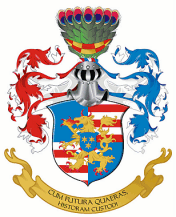


Welcome to the Societas Heraldica Slovenica or the SHS. The Society is composed of individuals who are professionals and non-professionals, academicians, historians and genealogists who share an interest in Slovenian heraldry. The SHS was created to encourage and promote the art and science and history of heraldry, in particular, Slovenian heraldry. The intent of the Society remains focused on heraldry, and is not involved with nor does it promote any political movement or belief system.
Heraldry has experienced a resurgence in popularity in many countries, including the Commonwealth nations such as Australia, Canada, England, Scotland, as well as European nations such as Austria, Czech Republic, France, Germany, Hungary, Poland, Portugal, Spain and Sweden, and to add, other nations such as Brasil, Mexico, Russia, South Africa and the United States. The heraldic rules of the ownership and transference of a coat of arms, and or assuming arms vary across different countries, whereby some countries may possess an authority or registrar which has been conveyed the authority to grant and/or register arms by that nation's sovereign or government. Other nations, such as the European nations and others, possess registrars in which the coats of arms are registered and/or archived in those acknowleged bodies, although, not necessarily officially recognized by that nation's sovereign or government.
There are, in general, two approaches in practice today with respect to the possession of armorial bearings, and the transference of armorial bearings from generation to generation. One approach under the English Laws of Arms, nations which following the British tradition, armorial bearings do not belong to all persons of a given surname and may only be rightfully be borne by direct decendants of the individual to whom the original armorial bearings were first granted. Other males within the family line could inherit the paternal arms, however, the arms are differenced in some way according to the country's rules of cadency. In Canada, this has been extended to include daughters with the caveat that they retain the original family surname. However, enforcement of such rules is at best cursory.
The second approach exists as a result of heraldic practices originating in the former "Holy Roman Empire". In Germany in particular, between 1350 and 1600, only 18 achievements of arms were granted by the Emperor. Most arms were and are self-styled, and the proclamation of the Emperor in the early Medieval period, stated that everyone will use arms as they wish. As a result of this proclamation, and the splitting up of the Holy Roman Empire into thousands of independent kingdoms in the 19th century, there are now millions of armorial bearings in use by families, and no centralized authority for the granting and registration of arms. The armorial bearings represented a family line, and not an individual. However, when a family line branches out, that branch of the family may change the armorial bearing slightly through a change in its tincture, add a charge or change the crest.
The intent of the Society is to formalize the possession of armorial bearings and the transference of the achievement through generations, through the education, encouragement and promotion of heraldry in Slovenia based on the approach utilized by the region based on historical accounts. Given that Slovenia was part of the Holy Roman Empire in its historical past, it is clear that the second approach would be the most compatible with the culture of Slovenia. However, further research is required in order to intelligently resurrect or to create a formalized system of heraldry that could be integrated with the culture and history of Slovenia. To that end, the Society will offer support to organization(s) whose purpose is the creation of a Slovenian Heraldic Registrar or Authority whose purpose is the registration/grant of personal arms as well as organizational/corporate/municipal arms and to create a structured Slovenian registry of those arms. The Society will encourage the registration of arms should such an organization be created and acknowledged by the powers that be. The Society will not incur this particular responsibility, in that it's purpose is the education, encouragement and promotion of heraldry. This will include activities such as hosting events, submitting papers on the subject of the art and science of heraldry, providing heraldic resources for study such as this website, and the possibility of offering services by acknowledged heraldic artists for the rendering of coats of arms requests.